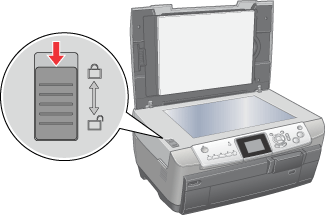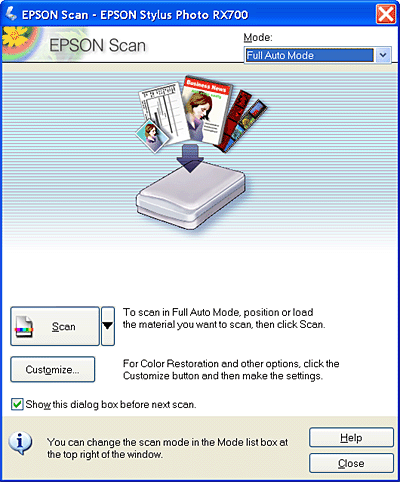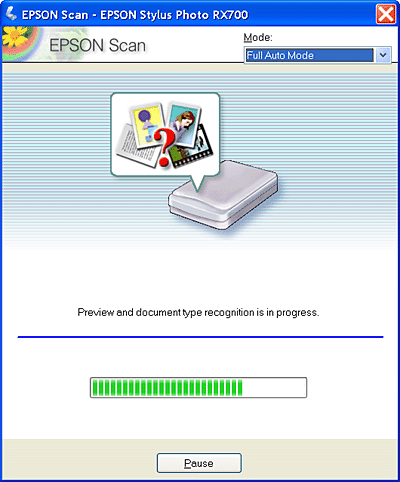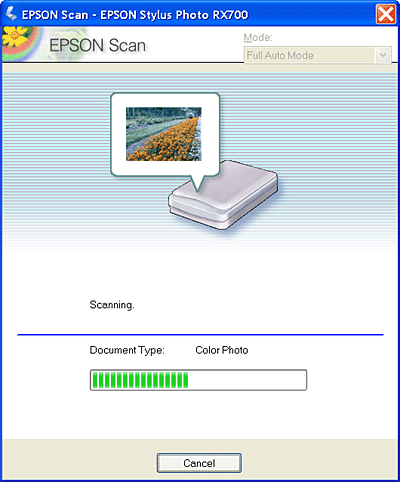|

User's Guide
|
|
Scanning / Basics Scanning Procedure
Scanning an Image
 Step1. Turning on this product
Step1. Turning on this product
 Step2. Placing your materials on the document table
Step2. Placing your materials on the document table
 Step3. Starting the software and scanning an image
Step3. Starting the software and scanning an image
EPSON Scan provides three modes for you to make any scanning settings: Full Auto Mode, Home Mode, and Professional Mode. This section describes how to scan an image in the Full Auto Mode. The Full Auto Mode lets you scan images using automatically-adjusted settings. For more details, see Choose the Appropriate Scanning Mode.
 |
Note:
|
 | |
You cannot scan an image with a size that exceeds the available memory or disk space. If you try to scan the image, an alert appears on the screen.
|
|
 |
Note for Macintosh users:
|
 | |
Most illustrations shown in this section are for Windows, so they may vary in appearance from what actually appears on your screen. The instructions are the same, except as noted.
|
|
 |
Caution:
|
 | |
Before starting the following steps, make sure that all the necessary software including EPSON Scan has been installed. For details about how to install the software, see the Start Here.
|
|
Step1. Turning on this product
 |
Before turning on this product, make sure the transportation lock is turned to the unlocked position and this product is connected to your computer.
|

 |
Press the  On button to turn on this product. The On light on the control panel remains lit, indicating that this product has completed its initialization. On button to turn on this product. The On light on the control panel remains lit, indicating that this product has completed its initialization.
|

[Top]
Step2. Placing your materials on the document table
You can scan two types of materials: transparent materials (like film) or reflective documents (like photo or paper). See the appropriate link below to set your materials on the document table.

[Top]
Step3. Starting the software and scanning an image
 |
Note for Mac OS X users:
|
 | |
Depending on your application, you may not be able to start EPSON Scan as described here.
|
|
You can start EPSON Scan in the following ways.
-
Start EPSON Scan directly as a stand alone application.
For details, see Start Scanner Software (EPSON Scan) Directly.
-
Start EPSON Scan from a TWAIN-compliant application.
For details to start from the EPSON Creativity Suite, see Scanning with the Scan and Save Function in EPSON Creativity Suite.
This section describes how to start EPSON Scan from ArcSoft PhotoImpression.
 |
Note for Mac OS X 10.3 users:
|
 | |
Do not use the Fast User Switching function while using this product.
|
|
 |
Start ArcSoft PhotoImpression.
|
Double-click the PhotoImpression 5 (PhotoImpression for Macintosh users) icon on your desktop.
You can also start the ArcSoft PhotoImpression in the way below.
For Windows users:
Click Start, point to All Programs (for Windows XP users) or Programs (for Windows Me, 98, or 2000 users), and select ArcSoft PhotoImpression 5. Click PhotoImpression 5.
For Macintosh users:
Double-click the Applications folder in Macintosh HD, and then double-click the PhotoImpression folder. Finally, double-click the PhotoImpression icon.
 |
Click the Camera/Scanner button on the main screen.
|
 |
In the Save my acquired photos section in the right of the main screen, select a file format from the File Format list. See File Format for more details.
|
Specify a location. If you want to change the default location, click the  folder icon and then select a desired folder.
folder icon and then select a desired folder.
 |
Click the EPSON Stylus Photo RX700 button.
|
 |  |
Note for Windows XP users:
|
 |  | |
Do not choose WIA-EPSON Stylus Photo RX700 from the menu to select this product. If you select it, you cannot use the Epson scanner function fully.
|
|
The standby dialog box appears.

If you want to make settings for Color Restoration and other options, click Customize to open the Customize dialog box. For more details on settings, see the online help by clicking the Help button in the Customize dialog box.
 |  |
Note:
|
 |  | |
When clearing the Show this dialog box before next scan check box, EPSON Scan automatically scans without displaying the standby dialog box. Then proceed to step 6.
|
|
 |
Click Scan.
|
 |
EPSON Scan automatically previews the image, and recognizes the document source and type.
|

 |  |
Note:
|
 |  | |
When clicking Pause, the standby dialog box in step 4 appears.
|
|
 |
After EPSON Scan has previewed and recognized the document type, the following window appears. You can see the previewed image in the window.
|

EPSON Scan automatically locates the target images and modifies their skew, and then starts scanning.
 |  |
Cautions:
|
 |  | |
Do not open the scanner unit during scanning or copying; otherwise, you may damage this product.
|
|
 |  |
Note:
|
 |  | |
Be aware that clicking Cancel on this screen terminates EPSON Scan.
|
|
 |
The scanned image is sent to ArcSoft PhotoImpression and saved to the specified folder.
|
 |
Note:
|
 | -
Depending on the image you want to scan, you may not get the expected scanned image. In this case, scan the image in the Home Mode or the Professional Mode.
|
|
 | -
When you scan in the Full Auto Mode, black and white document might be recognized as color document. In this case, scan the image in the Home Mode or Professional Mode.
|
|
 | -
If the edge of the document is not scanned correctly, place the document slightly away from the edge of the document table. See Placing Documents and Photos for details.
|
|
 | -
For information on further editing of the scanned images, refer to your application's documentation.
|
|
File Format
The following table lists some common image file formats available in Arcsoft PhotoImpression 5. Select an appropriate file format before scanning images.
|
Format (File extension)
|
Explanation
|
|
BITMAP (*.BMP)
|
A standard image file format for Windows. Most Windows applications including word processing applications can read and prepare images in this format.
|
|
JPEG (*.JPG)
|
A compressed file format. The compression quality can be selected. The JPEG format enables relatively high compression ratio. However, the higher the compression ratio is, the lower the image quality becomes. (Note that the original data cannot be restored.) In addition, the quality deteriorates every time the data is saved. The TIFF format is recommended in cases where modification, retouch and the like are required.
|
|
PNG format (*.PNG)
(for Windows only)
|
PNG is a portable and highly-compressed file format designed for viewing in Web browsing applications, which allows a choice in compression quality. The image quality does not deteriorate when the image file is saved in PNG.
|
|
TIFF (*.TIF)
|
A file format created for exchanging data among many applications, such as graphic and DTP software. When scanning black & white images, you can specify the compression type.
|

[Top]
| Version NPD1043-00, Copyright © 2005, SEIKO EPSON CORPORATION |
Step1. Turning on this product
Step2. Placing your materials on the document table
Step3. Starting the software and scanning an image
folder icon and then select a desired folder.